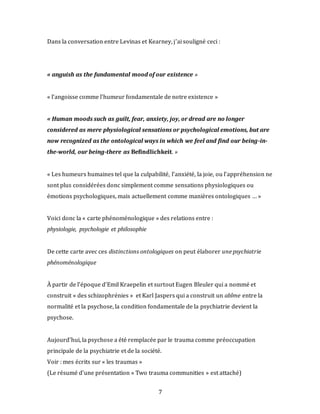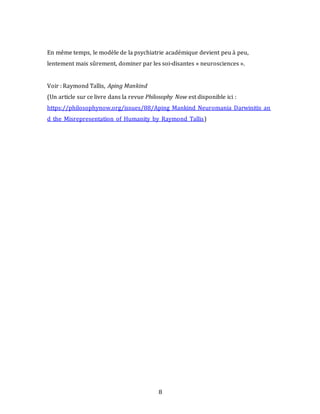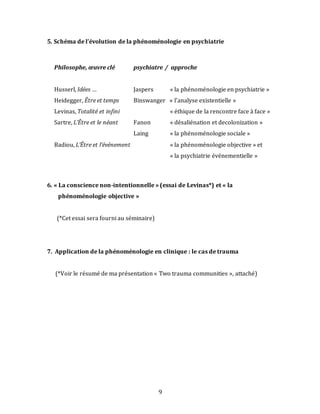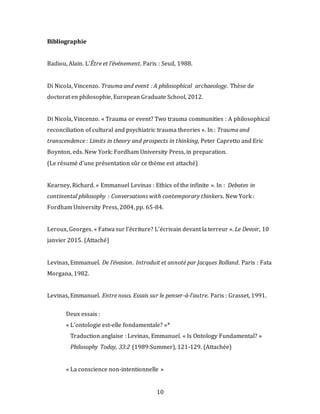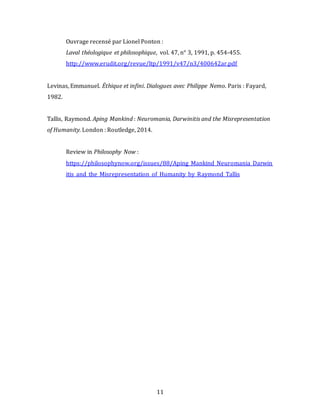« Penser Levinas en philosophie et psychiatrie » présenté par Vincenzo Di Nicola - Séminaire Sciences humaines et psychiatrie - 22.01.2015
- 1. 1 SÉMINAIRE SCIENCES HUMAINES ET PSYCHIATRIE ANNÉE ACADÉMIQUE 2014-2015 Emmanuel Levinas et la relation à l’autre 2e semestre « Penser Levinas en philosophie et psychiatrie » 22 janvier 2015 17h00 – 19h30 Vincenzo Di Nicola Université de Montréal Hôpital Maisonneuve-Rosemont
- 2. 2 « Penser Levinas en philosophie et psychiatrie » Armature du séminaire 1. Trois « gestes philosophiques » 2. « Le visage et le nom » : la relation à l’autre ou la phénoménologie incarnée 3. « L’ontologie est-elle fondamentale? » (essai de Levinas) 4. Qu’est-ce que la phénoménologie? 5. Schéma de l’évolution de la phénoménologie en psychiatrie 6. « La conscience non-intentionnelle » (essai de Levinas) et « la phénoménologie objective » 7. Application de la phénoménologie en clinique : le cas de trauma
- 3. 3 « Penser Levinas en philosophie et psychiatrie » 1. Trois « gestes philosophiques » « Le rire » (Aristote, Nietzsche, Foucault) « Le silence » (Wittgenstein) « Le dialogue/la rencontre » (Socrate, Bakhtine, Buber, Levinas) 2. « Le visage et le nom » : la relation à l’autre ou la phénoménologie incarnée (*Voir l’article de Georges Leroux, « Fatwa sur l’écriture? L’écrivain devant la terreur », Le Devoir, 10 janvier 2015, attaché) 3. « L’ontologie est-elle fondamentale? » (essai de Levinas*) (*Cet essai sera fourni au séminaire, une traduction anglaise est attachée) 4. Qu’est-ce que la phénoménologie? (*Voir extrait de l’entretien avec Levinas, ici-bas)
- 4. 4 Qu’est-ce que la phénoménologie? Extrait de la conversation entre Emmanuel Levinas et Richard Kearney (pp. 66-68) RK: How would you characterize the particular contributions of phenomenology to modern philosophy? EL: The most fundamental contribution of Husserl’s phenomenology is its methodical disclosure of how meaning comes to be, how it emerges in our consciousness of the world, or, more precisely, in our becoming conscious of our intentional rapport (visée) with the world. The phenomenological method enables us to discover meaning within our lived experience; it reveals consciousness to be an intentionality always in contact with objects outside of itself, other than itself. Human experience is not some self-transparent substance or pure cogito; it is always intending or tending towards something in the world which preoccupies it. The phenomenological method permits consciousness to understand its own preoccupations, to reflect upon itself and thus discover all the hidden or neglected horizons of consciousness, phenomenology enables us to explicate or unfold the full intentional meaning of an object, which would otherwise be presented as an abstract and isolated entity cut off from its intentional horizons. Phenomenology thus teaches us that consciousness is at once tied to the object of its experience and yet free to detach itself from this object in order to return upon itself, focusing on those visées of intentionality in which the object emerges as meaningful, as part of our lived experience. One might say that phenomenology is a way of becoming aware of where we are in the world, a sich besinnen which consists of a recovery of the origin of meaning in our life-world or Lebenswelt.
- 5. 5 RK: Your second major work was entitled En découvrant l’existence avec Husserl et Heidegger [Discovering Existence with Husserl and Heidegger]. If Husserl introduced you to the phenomenological method, how would you assess your debt to Heidegger? EL: Heidegger’s philosophy was a shock for me, and for most of my contemporaries in the late twenties and thirties. It completely altered the course and character of European philosophy. I think that one cannot seriously philosophize today without traversing the Heideggerian path in some form or another. Being and Time, which is much more significant and profound than any of Heidegger’s later works, represents the fruition and flowering of Husserlian phenomenology. The most far-reaching potentialities of the phenomenological method were exploited by Heidegger in this early work and particularly in his phenomenological analysis of anguish as the fundamental mood of our existence. Heidegger brilliantly described how this existential mood, or Stimmung, revealed the way in which we were attuned to Being. Human moods such as guilt, fear, anxiety, joy, or dread are no longer considered as mere physiological sensations or psychological emotions, but are now recognized as the ontological ways in which we feel and find our being-in-the-world, our being-there as Befindlichkeit. RK: This phenomenological analysis of our existential moods was, of course, something which you yourself used to original effect in your descriptions of such human dispositions as need, desire, effort, laziness, and insomnia in Existence and Existents. EL: Husserl’s approach was always more abstract and ponderous … Husserl was primarily concerned with establishing and perfecting phenomenology as a method, that is, as an epistemological method of describing how our logical concepts and categories emerge and assume an essential meaning. What is the relation between our logical judgments and our perceptual experience? This was Husserl’s question— and phenomenology was his method of responding, by means of rigorous and exact descriptions of our intentional modes of consciousness. Phenomenology was thus a way of suspending our preconceptions and prejudices in order to disclose how
- 6. 6 essential truth and meaning are generated; it was a methodical return to the beginnings, to the origins of knowledge. On the other hand, Heidegger, the young disciple, brought the phenomenological method to life and gave it a contemporary style and relevance. Heidegger’s existential analyses possessed a poetic quality and force which enchanted and astonished the mind, while preserving all the while the rigorous contours of the master’s method. So that I would say, by way of summary, that if it was Husserl who opened up for me the radical possibilities of a phenomenological analysis of knowledge, it was Heidegger who first gave these possibilities a positive and concrete grounding in our everyday existence. Heidegger showed that the phenomenological search for eternal truths and essences ultimately originates in time, in our temporal and historical existence. Référence : Kearney, Richard. « Emmanuel Levinas: Ethics of the Infinite ». In : Debates in Continental Philosophy. Conversations with Contemporary Thinkers. New York : Fordham University Press, 2004, pp. 65-84.
- 7. 7 Dans la conversation entre Levinas et Kearney, j’ai souligné ceci : « anguish as the fundamental mood of our existence » « l’angoisse comme l’humeur fondamentale de notre existence » « Human moods such as guilt, fear, anxiety, joy, or dread are no longer considered as mere physiological sensations or psychological emotions, but are now recognized as the ontological ways in which we feel and find our being-in- the-world, our being-there as Befindlichkeit. » « Les humeurs humaines tel que la culpabilité, l’anxiété, la joie, ou l’appréhension ne sont plus considérées donc simplement comme sensations physiologiques ou émotions psychologiques, mais actuellement comme manières ontologiques … » Voici donc la « carte phénoménologique » des relations entre : physiologie, psychologie et philosophie De cette carte avec ces distinctions ontologiques on peut élaborer une psychiatrie phénoménologique À partir de l’époque d’Emil Kraepelin et surtout Eugen Bleuler qui a nommé et construit « des schizophrénies » et Karl Jaspers qui a construit un abîme entre la normalité et la psychose, la condition fondamentale de la psychiatrie devient la psychose. Aujourd’hui, la psychose a été remplacée par le trauma comme préoccupation principale de la psychiatrie et de la société. Voir : mes écrits sur « les traumas » (Le résumé d’une présentation « Two trauma communities » est attaché)
- 8. 8 En même temps, le modèle de la psychiatrie académique devient peu à peu, lentement mais sûrement, dominer par les soi-disantes « neurosciences ». Voir : Raymond Tallis, Aping Mankind (Un article sur ce livre dans la revue Philosophy Now est disponible ici : https://philosophynow.org/issues/88/Aping_Mankind_Neuromania_Darwinitis_an d_the_Misrepresentation_of_Humanity_by_Raymond_Tallis)
- 9. 9 5. Schéma de l’évolution de la phénoménologie en psychiatrie Philosophe, œuvre clé psychiatre / approche Husserl, Idées … Jaspers « la phénoménologie en psychiatrie » Heidegger, Être et temps Binswanger « l’analyse existentielle » Levinas, Totalité et infini « éthique de la rencontre face à face » Sartre, L’Être et le néant Fanon « désaliénation et decolonization » Laing « la phénoménologie sociale » Badiou, L’Être et l’événement « la phénoménologie objective » et « la psychiatrie événementielle » 6. « La conscience non-intentionnelle » (essai de Levinas*) et « la phénoménologie objective » (*Cet essai sera fourni au séminaire) 7. Application de la phénoménologie en clinique : le cas de trauma (*Voir le résumé de ma présentation « Two trauma communities », attaché)
- 10. 10 Bibliographie Badiou, Alain. L’Être et l’événement. Paris : Seuil, 1988. Di Nicola, Vincenzo. Trauma and event : A philosophical archaeology. Thèse de doctorat en philosophie, European Graduate School, 2012. Di Nicola, Vincenzo. « Trauma or event? Two trauma communities : A philosophical reconciliation of cultural and psychiatric trauma theories ». In : Trauma and transcendence : Limits in theory and prospects in thinking, Peter Capretto and Eric Boynton, eds. New York: Fordham University Press, in preparation. (Le résumé d’une présentation sûr ce thème est attaché) Kearney, Richard. « Emmanuel Levinas : Ethics of the infinite ». In : Debates in continental philosophy : Conversations with contemporary thinkers. New York : Fordham University Press, 2004, pp. 65-84. Leroux, Georges. « Fatwa sur l’écriture? L’écrivain devant la terreur ». Le Devoir, 10 janvier 2015. (Attaché) Levinas, Emmanuel. De l’évasion. Introduit et annoté par Jacques Rolland. Paris : Fata Morgana, 1982. Levinas, Emmanuel. Entre nous. Essais sur le penser-à-l’autre. Paris : Grasset, 1991. Deux essais : « L’ontologie est-elle fondamentale? »* Traduction anglaise : Levinas, Emmanuel. « Is Ontology Fundamental? » Philosophy Today, 33:2 (1989:Summer), 121-129. (Attachée) « La conscience non-intentionnelle »
- 11. 11 Ouvrage recensé par Lionel Ponton : Laval théologique et philosophique, vol. 47, n° 3, 1991, p. 454-455. http://www.erudit.org/revue/ltp/1991/v47/n3/400642ar.pdf Levinas, Emmanuel. Éthique et infini. Dialogues avec Philippe Nemo. Paris : Fayard, 1982. Tallis, Raymond. Aping Mankind : Neuromania, Darwinitis and the Misrepresentation of Humanity. London : Routledge, 2014. Review in Philosophy Now : https://philosophynow.org/issues/88/Aping_Mankind_Neuromania_Darwin itis_and_the_Misrepresentation_of_Humanity_by_Raymond_Tallis

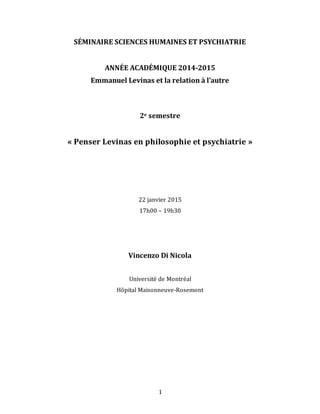
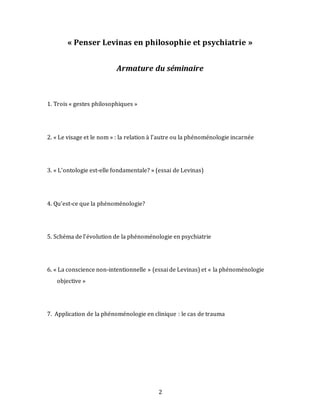
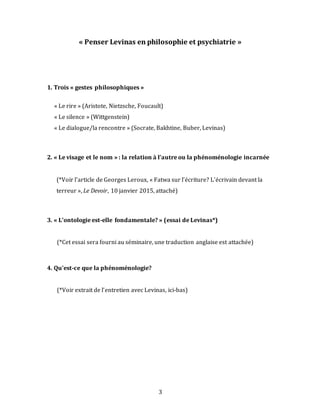
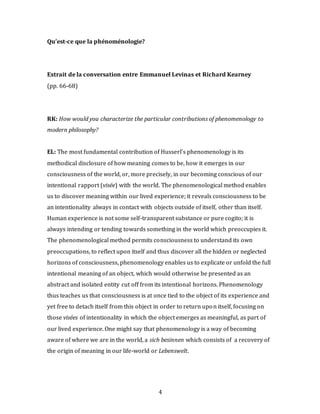
![5
RK: Your second major work was entitled En découvrant l’existence avec Husserl et
Heidegger [Discovering Existence with Husserl and Heidegger]. If Husserl introduced
you to the phenomenological method, how would you assess your debt to Heidegger?
EL: Heidegger’s philosophy was a shock for me, and for most of my contemporaries
in the late twenties and thirties. It completely altered the course and character of
European philosophy. I think that one cannot seriously philosophize today without
traversing the Heideggerian path in some form or another. Being and Time, which is
much more significant and profound than any of Heidegger’s later works, represents
the fruition and flowering of Husserlian phenomenology. The most far-reaching
potentialities of the phenomenological method were exploited by Heidegger in this
early work and particularly in his phenomenological analysis of anguish as the
fundamental mood of our existence. Heidegger brilliantly described how this
existential mood, or Stimmung, revealed the way in which we were attuned to Being.
Human moods such as guilt, fear, anxiety, joy, or dread are no longer
considered as mere physiological sensations or psychological emotions, but
are now recognized as the ontological ways in which we feel and find our
being-in-the-world, our being-there as Befindlichkeit.
RK: This phenomenological analysis of our existential moods was, of course, something
which you yourself used to original effect in your descriptions of such human
dispositions as need, desire, effort, laziness, and insomnia in Existence and Existents.
EL: Husserl’s approach was always more abstract and ponderous … Husserl was
primarily concerned with establishing and perfecting phenomenology as a method,
that is, as an epistemological method of describing how our logical concepts and
categories emerge and assume an essential meaning. What is the relation between
our logical judgments and our perceptual experience? This was Husserl’s question—
and phenomenology was his method of responding, by means of rigorous and exact
descriptions of our intentional modes of consciousness. Phenomenology was thus a
way of suspending our preconceptions and prejudices in order to disclose how](https://image.slidesharecdn.com/seminairelevinas-dinicola-philosophieetpsychiatrie-2015-150124132504-conversion-gate01/85/Penser-Levinas-en-philosophie-et-psychiatrie-presente-par-Vincenzo-Di-Nicola-Seminaire-Sciences-humaines-et-psychiatrie-22-01-2015-5-320.jpg)

